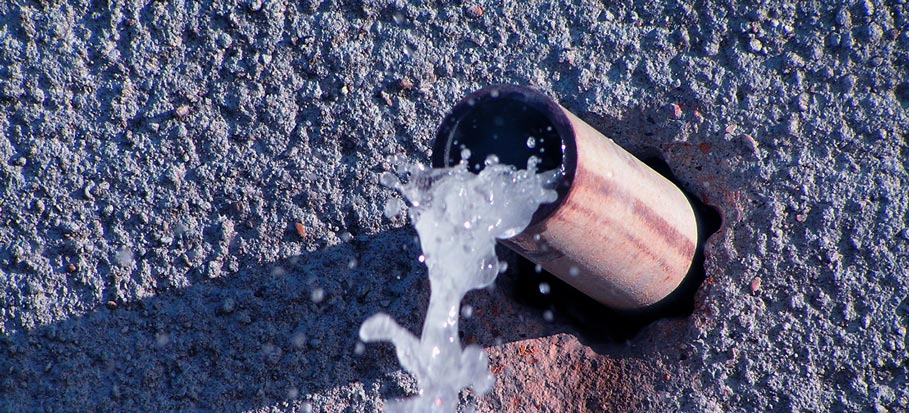6 Ways to Locate Hidden Water Leakages in Your House
6 Ways to Locate Hidden Water Leakages in Your House
Blog Article
Here in the next paragraph you can get a lot of incredibly good insights pertaining to Leaking water lines.

Early detection of dripping water lines can reduce a possible disaster. Some small water leaks might not be noticeable.
1. Analyze the Water Meter
Examining it is a surefire way that aids you discover leaks. If it relocates, that shows a fast-moving leakage. This indicates you might have a sluggish leakage that can even be underground.
2. Check Water Consumption
If you identify sudden changes, regardless of your usage being the same, it suggests that you have leaks in your plumbing system. An abrupt spike in your bill suggests a fast-moving leakage.
A consistent boost every month, also with the very same habits, reveals you have a slow leakage that's also gradually rising. Call a plumber to extensively examine your residential property, particularly if you really feel a cozy location on your floor with piping underneath.
3. Do a Food Coloring Examination
30% comes from toilets when it comes to water intake. Test to see if they are running effectively. Drop specks of food color in the container and wait 10 mins. If the color in some way infiltrates your dish throughout that time without flushing, there's a leak between the tank and also bowl.
4. Asses Outside Lines
Do not fail to remember to examine your outside water lines too. Examination spigots by connecting a garden hose pipe. Should water permeate out of the link, you have a loose rubber gasket. Change this and ensure all connections are limited. It will help obtain it skillfully checked out as well as kept every year if you've obtained a sprinkler system. One small leakage can waste tons of water as well as spike your water costs.
5. Examine and also Examine the Situation
Homeowners need to make it a practice to check under the sink counters as well as also inside closets for any kind of bad odor or mold and mildew growth. These 2 warnings suggest a leak so timely interest is required. Doing regular inspections, also bi-annually, can save you from a significant issue.
Inspect for stainings and also weakening as many pipes as well as devices have a life expectations. If you presume dripping water lines in your plumbing system, do not wait for it to rise.
Early detection of leaking water lines can reduce a prospective disaster. Some tiny water leaks might not be visible. Examining it is a surefire method that helps you find leaks. One small leakage can waste heaps of water and surge your water expense.
If you presume dripping water lines in your plumbing system, do not wait for it to escalate.
How to Know If Your Home Has a Hidden Leak
Water Meter Reveals Inexplicable Water Usage
If you’d like to test whether or not there’s a leak somewhere in your home, you can do this using your water meter. Here is how to conduct the test:
Don’t use any water in your home for at least 30 minutes; this also means not turning on faucets or water-using appliances.
Go outside, and check your water meter for activity.
If your water meter shows that there was activity, even though no one was using any water, this proves that there is a leak in your home.Visible Mold or Mildew Growth
Leaks behind walls create moist, dark environments that allow mold and mildew to grow and thrive. Eventually, you might see mold growth forming on the wall closest to a hidden leak.
If mold is growing in an area that receives a high amount of moisture, such as a bathroom, it may simply be an indication that better ventilation is needed. However, if you see mold growth on a wall or the ceiling in an area where you would not expect, you probably have a hidden leak.
Musty, Mildew Odor
Sometimes you might not be able to see the mold or mildew that is growing as a result of a leak. However, the smell can give the problem away just as easily. If you catch a whiff of something musty, there’s a good chance that old water is collecting somewhere in your home that you can’t see.
Stained/Warped Walls, Ceilings, or Floors
When your home soaks up water, a variety of red flags can become visible, including ceiling stains, bubbling drywall, warped walls, and sagging floors. While these issues can be caused by excess humidity, they can also be signs that a pipe or plumbing connection has started leaking behind your walls.
Inexplicably High Water Bill
After a while, you get a general sense for what your water bill should be. If you own a pool or sprinkler system, your bill will tend to be higher during summer. However, if you receive a water bill that seems especially high, and you can’t figure out what caused it, then you may have a hidden leak somewhere that’s increasing your bill.
https://www.plumbingjoint.com/blog/2019/july/how-to-know-if-your-home-has-a-hidden-leak/

As an enthusiastic person who reads about Leaking water lines, I assumed sharing that article was a great idea. For those who enjoyed our post please make sure you remember to share it. Thank you so much for taking the time to read it.
Report this page